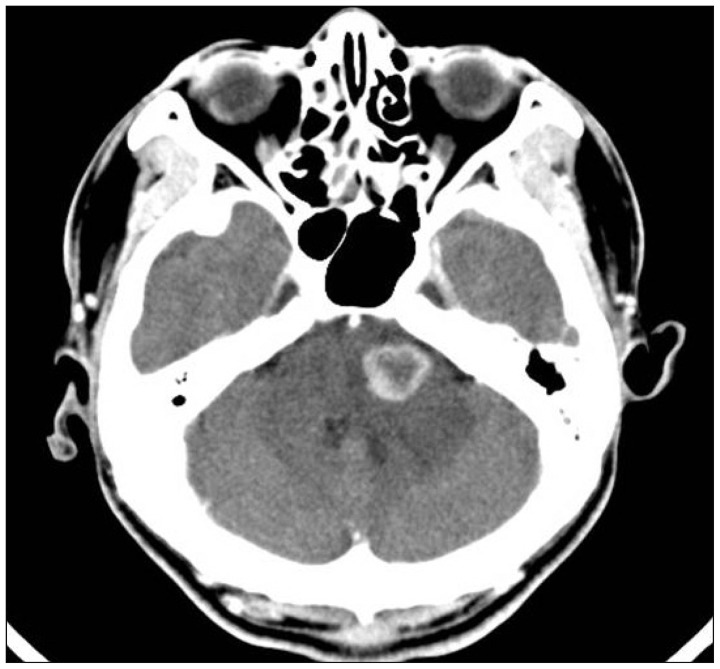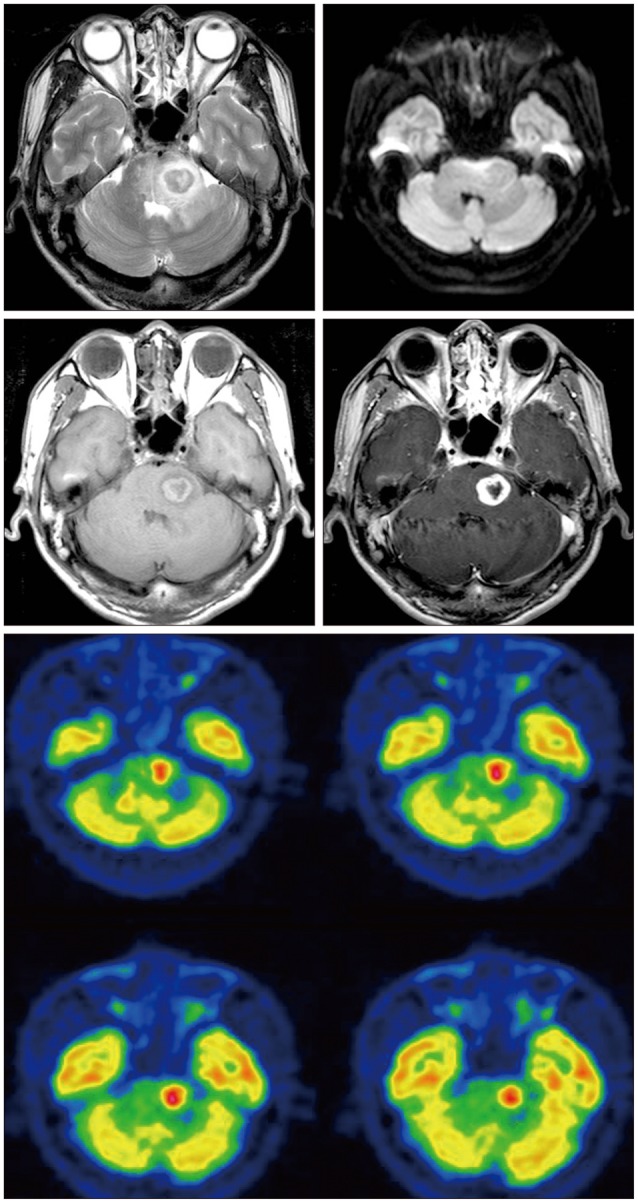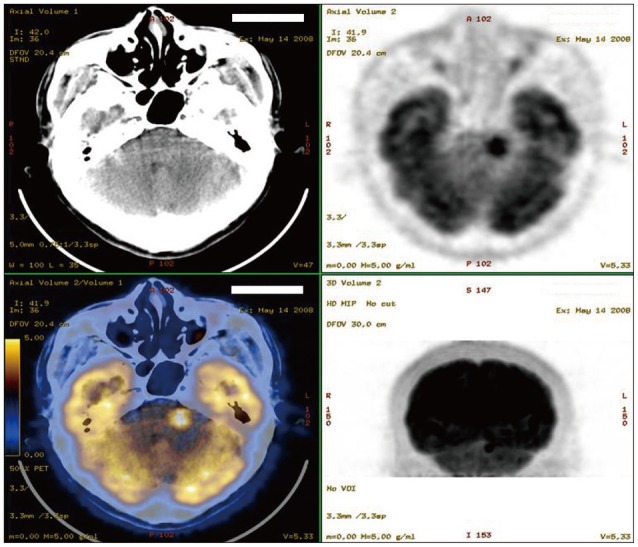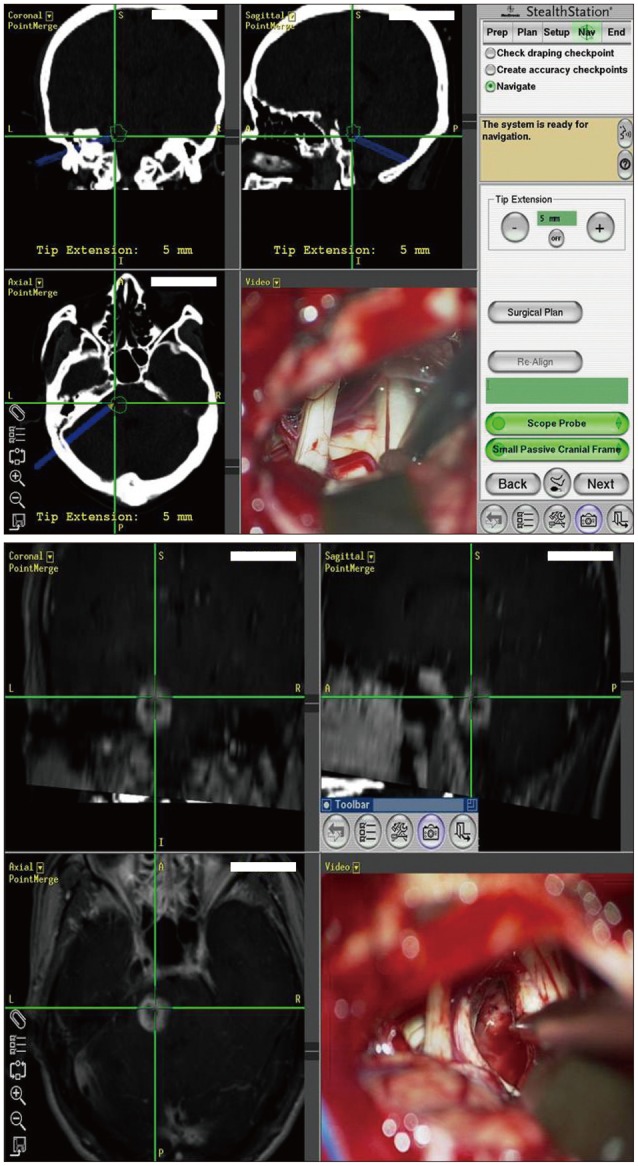J Korean Neurosurg Soc.
2015 Jan;57(1):50-53. 10.3340/jkns.2015.57.1.50.
Cryptococcal Brainstem Abscess Mimicking Brain Tumors in an Immunocompetent Patient
- Affiliations
-
- 1Department of Neurosurgery, School of Medicine, Ajou University, Suwon, Korea.
- 2Department of Pathology, School of Medicine, Ajou University, Suwon, Korea.
- 3Department of Neurosurgery, Kangwon National University, Chuncheon, Korea.
- 4Department of Neurosurgery, CHA University College of Medicine, Seongnam, Korea. sandori50@gmail.com
- KMID: 2067091
- DOI: http://doi.org/10.3340/jkns.2015.57.1.50
Abstract
- Usually fungal infections caused by opportunistic and pathogenic fungi had been an important cause of morbidity and mortality among immunocompromised patients. However clinical data and investigations for immunocompetent pathogenic fungal infections had been rare and neglected into clinical studies. Especially Cryptococcal brainstem abscess cases mimicking brain tumors were also much more rare. So we report this unusual case. This 47-year-old man presented with a history of progressively worsening headache and nausea for 1 month and several days of vomituritions before admission. Neurological and laboratory examinations performed demonstrated no abnormal findings. Previously he was healthy and did not have any significant medical illnesses. A CT and MRI scan revealed enhancing 1.8x1.7x2.0 cm mass lesion in the left pons having central necrosis and peripheral edema compressing the fourth ventricle. And also positron emission tomogram scan demonstrated a hot uptake of fluoro-deoxy-glucose on the brainstem lesion without any evidences of systemic metastasis. Gross total mass resection was achieved with lateral suboccipital approach with neuronavigation system. Postoperatively he recovered without any neurological deficits. Pathologic report confirmed Cryptococcus neoformans and he was successively treated with antifungal medications. This is a previously unreported rare case of brainstem Cryptococcal abscess mimicking brain tumors in immunocompetent host without having any apparent typical meningeal symptoms and signs with resultant good neurosurgical recovery.
MeSH Terms
Figure
Reference
-
1. Abernathey CD, Camacho A, Kelly PJ. Stereotaxic suboccipital transcerebellar biopsy of pontine mass lesions. J Neurosurg. 1989; 70:195–200. PMID: 2643686.
Article2. Al-Tawfiq JA, Ghandour J. Cryptococcus neoformans abscess and osteomyelitis in an immunocompetent patient with tuberculous lymphadenitis. Infection. 2007; 35:377–382. PMID: 17885733.
Article3. Casadeval A, Perfect JR. Cryptococcus neoformans. Washington DC: ASM Press;1998. p. 541.4. Coffey RJ, Lunsford LD. Stereotactic surgery for mass lesions of the midbrain and pons. Neurosurgery. 1985; 17:12–18. PMID: 3895028.
Article5. Cunha BA. Central nervous system infections in the compromised host: a diagnostic approach. Infect Dis Clin North Am. 2001; 15:567–590. PMID: 11447710.
Article6. Gologorsky Y, DeLaMora P, Souweidane MM, Greenfield JP. Cerebellar cryptococcoma in an immunocompetent child. Case report. J Neurosurg. 2007; 107(4 Suppl):314–317. PMID: 17941497.7. Hakyemez B, Erdogan C, Bolca N, Yildirim N, Gokalp G, Parlak M. Evaluation of different cerebral mass lesions by perfusion-weighted MR imaging. J Magn Reson Imaging. 2006; 24:817–824. PMID: 16958061.
Article8. Saag MS, Powderly WG, Cloud GA, Robinson P, Grieco MH, Sharkey PK, et al. The NIAID Mycoses Study Group and the AIDS Clinical Trials Group. Comparison of amphotericin B with fluconazole in the treatment of acute AIDS-associated cryptococcal meningitis. N Engl J Med. 1992; 326:83–89. PMID: 1727236.
Article
- Full Text Links
- Actions
-
Cited
- CITED
-
- Close
- Share
- Similar articles
-
- A Case of Cryptococcal Abscess Involving Deep Neck Space in an Immunocompetent Patient
- Cryptococcal Abscess in the Pubic Region and Central Nervous System of an Immunocompetent Patient
- Cryptococcal Meningitis Complicated by a Brain Abscess and an Abdominal Pseudocyst Following Ventriculoperitoneal Shunting
- Concurrent Nocardia Related Brain Abscess and Semi-Invasive Pulmonary Aspergillosis in an Immunocompetent Patient
- Nocardia Brain Abscess in an Immunocompetent Patient






